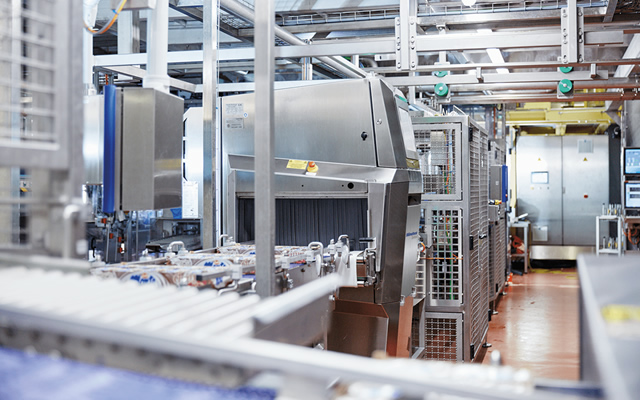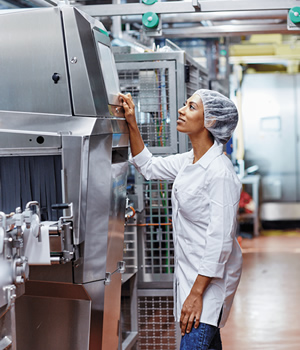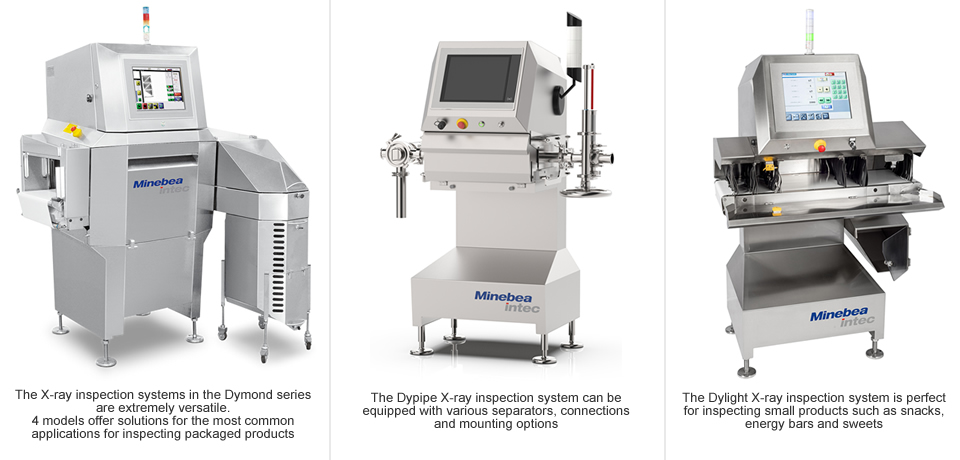The use of X-ray inspection systems in the food industry has increased significantly in recent years. These systems have proven to be a worthwhile investment in product safety, integrity and quality. Minebea Intec, a leading global manufacturer of industrial weighing and inspection technologies, offers innovative x-ray systems to ensure the highest safety and quality standards in food production.
Between the rhythmic whirring of machines, the rattling of packaging and the tantalising aroma of freshly produced delicacies, X-ray inspection systems occupy an important place in many production halls around the world.
X-ray inspection systems not only recognise products that are contaminated with metal, glass, rubber, stones, plastic parts or bone splinters, they also enable inline quality checks such as weight determination, counting of components, detection of missing or defective products, fill level control and checking the integrity of closures. As part of the HACCP concept (Hazard Analysis and Critical Control Points), they help to fulfil the increasing requirements of consumers, authorities and protect manufacturing companies from costly and brand-damaging product recalls.

Multi-track solutions for up to 8 lines with one detector are possible
X-ray inspection: how does it work?
X-ray machines in the food industry work in much the same way as X-ray machines at airports check luggage for security reasons. The product runs on a conveyor belt at a constant speed through the X-ray beam. As the product continues to move, a new image line is generated at regular intervals (e.g. every 0.8mm). Once the product has been fully recorded, the greyscale image generated is analysed and inspected for foreign objects.
Liang Mengqi, Global Product Manager at Minebea Intec, said:
 X-ray inspection systems recognise contaminated products by the fact that foreign bodies such as metal absorb X-rays more than the actual food product. Hence, the success of foreign body detection depends on the density of the foreign bodies. For example, Minebea Intec X-ray machine could detect 2mm metal wire inside of a yoghurt where the conventional metal detector has no chance. Because the metal detector will be stopped due to the aluminum foil from the yoghurt packaging.
X-ray inspection systems recognise contaminated products by the fact that foreign bodies such as metal absorb X-rays more than the actual food product. Hence, the success of foreign body detection depends on the density of the foreign bodies. For example, Minebea Intec X-ray machine could detect 2mm metal wire inside of a yoghurt where the conventional metal detector has no chance. Because the metal detector will be stopped due to the aluminum foil from the yoghurt packaging.
How do you select the proper X-ray system?
 Minebea Intec offers a large portfolio of X-ray systems for the inspection of packaged products. Typical applications include cartons, boxes, bags, pouches, trays and portion packs, which can contain a wide variety of dry or liquid foods. To select a suitable X-ray system for the production, the product and its orientation need to be considered.
Minebea Intec offers a large portfolio of X-ray systems for the inspection of packaged products. Typical applications include cartons, boxes, bags, pouches, trays and portion packs, which can contain a wide variety of dry or liquid foods. To select a suitable X-ray system for the production, the product and its orientation need to be considered.
Systems with top-mounted X-ray generators are the most common in the food industry, where the X-ray beam hits the product directly from above. These inspection systems are usually installed at the end of a production line and inspect the packaged products. For this purpose, the packs are positioned flat on the belt so that the X-ray beam could pass through as less pack thickness as possible, which attributes to the higher detection sensitivity.
The Dylight and Dymond models have been specially developed for these applications. They are characterised by a hygienic design and high detection sensitivity with low power consumption.
Systems with a side-mounted X-ray generator, where the X-ray beam reaches the conveyor belt from the side, are often used for the upright products such as a jar of baby food. In this case too, the product must be aligned so that it passes the detector system with the upright side facing the X-ray beam. For example, the Dymond S as a sideshooter X-ray, combines high detection sensitivity with low power consumption. The unit is optionally available with a so-called chicane belt. Ideal for those situations where only very limited space is available. Dymond D is a dual-beam X-ray inspection system that produces two X-ray images at a 90° angle.
Whether it's tins, Tetra Paks or glass jars, multi-sided inspection provides maximum safety thus opening up a wealth of possibilities for manufacturers in product design.
Special designs of X-ray inspection
Minebea Intec recently launched the Dypipe X-ray inspection system for viscous and liquid products.
Liang Mengqi said:
 The Dypipe is equipped with an innovative test specimen insertion system that enables the test specimens to be inspected during operation. This means that manufacturing companies can be sure at all times that their production processes are running smoothly and safely.
The Dypipe is equipped with an innovative test specimen insertion system that enables the test specimens to be inspected during operation. This means that manufacturing companies can be sure at all times that their production processes are running smoothly and safely.
In order to meet the high hygiene requirements for meat applications, the Dypipe is equipped with an easy-to-open separator that was specially developed for this purpose. This system guarantees excellent results and gives the certainty of producing high-quality food.
Another special design of X-ray inspection systems is the Dymond Bulk. It guarantees precise X-ray inspection of bulk materials in the food industry. Foreign bodies such as stones or metal are consistently detected and removed from the material flow to protect both products and machines. Dymond Bulk has outstanding detection performance for raw materials such as vegetables, nuts, dried fruits or cereals: an optional multi-segment separator with four segments also guarantees the targeted and cost-effective elimination of foreign bodies from the product stream.
Everything from a single source
The sophisticated X-ray inspection systems that optimise production lines are just one part of Minebea Intec's comprehensive product portfolio. Whether checkweighers with high-speed function, robust load cells for your container or silo weighing, high-precision industrial scales or intuitive software solutions: Minebea Intec supports its customers throughout the entire project phase with customised solutions. So that customers' freshly produced food not only smells good, but can also be consumed without hesitation.

Picture credits: Minebea Intec